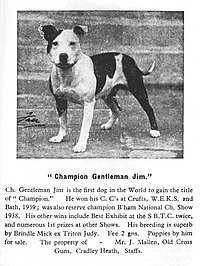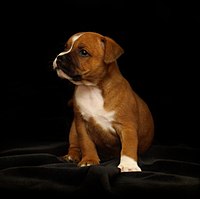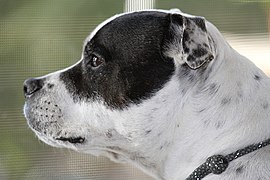| Revision as of 21:04, 9 July 2019 editNormal Op (talk | contribs)Extended confirmed users7,816 edits →Breed-specific legislation: Removed sentence irrelevant to the section and the article. Fixed links and punctuation in the following sentence.← Previous edit | Revision as of 21:07, 9 July 2019 edit undoAtsme (talk | contribs)Autopatrolled, Extended confirmed users, Page movers, New page reviewers, Pending changes reviewers, Rollbackers42,813 edits Reverted 3 edits by Nomopbs (talk): No, not irrelevant, but I will replace world-wide reference (TW)Tag: UndoNext edit → | ||
| Line 100: | Line 100: | ||
| ===Breed-specific legislation=== | ===Breed-specific legislation=== | ||
| {{main|Breed-specific legislation}} | {{main|Breed-specific legislation}} | ||
| Some ] and/or ]s in the US, Ireland, New South Wales, New Zealand, Canada, Spain, Turkey, and the UK<ref name=DB>{{cite web|url=https://www.dogsbite.org/legislating-dangerous-dogs-state-by-state.php |title=International BSL|publisher=DogsBite.org|access-date=9 July 2018}}</ref> have placed restrictions on the ownership of the "pit bull class" of dogs which typically comprise a variety of different breeds, including the English Bull Terrier, ], ], Staffordshire Bull Terrier, Dalmatian, ], ], ], ], ] ], and any mix or even a resemblance of those dogs.<ref name=ASPCA/> In the US, the ASPCA has stood in opposition to breed-specific legislation, referring to it as "breed-discriminatory laws" which have proven to be ineffective. There are some municipalities in the US that subject owners of Staffies to breed-specific regulations, despite the breed's long history of responsible breeding and recognition by the AKC as a family dog,<ref name=ASPCA/> whereas in the United Kingdom, Australia and New Zealand, they are not restricted by any breed-specific legislation.<ref name=Potts/> | |||
| AKC considers ] "a slippery slope" stating that "any dog can be exploited and trained to be aggressive" and expressed concern because they believe "breed-specific bans ultimately punish responsible dog owners, while doing very little to actually punish irresponsible owners."<ref name="Relations 2018">{{cite web | last=Relations | first=AKC Government | title=Why Breed Bans Affect You – American Kennel Club | website=American Kennel Club | date=2018-02-01 | url=https://www.akc.org/expert-advice/news/breed-bans-affect/ | access-date=2019-05-24}}</ref> In 2018 ] lobbied the British Parliament to have the Staffordshire Bull Terrier added to the list of dog breeds covered by the ] but the idea was rejected by parliament, the ], the Kennel Club, ], ] and the Battersea Dogs & Cats Home; all objected to the proposed ban.<ref name=Winter/> | |||
| ====Irish Staffordshire Bull Terrier==== | ====Irish Staffordshire Bull Terrier==== | ||
Revision as of 21:07, 9 July 2019
Dog breed
| Staffordshire Bull Terrier | |||||||||||||||||||||||
|---|---|---|---|---|---|---|---|---|---|---|---|---|---|---|---|---|---|---|---|---|---|---|---|
 | |||||||||||||||||||||||
| Common nicknames | Stafford & Staffie | ||||||||||||||||||||||
| Origin | England | ||||||||||||||||||||||
| Foundation stock | Black and Tan Terrier Old English Bulldog Bull and Terrier | ||||||||||||||||||||||
| |||||||||||||||||||||||
| |||||||||||||||||||||||
| Dog (domestic dog) | |||||||||||||||||||||||
The Staffordshire Bull Terrier, also known as Staffie, is a breed of short-haired, small to medium sized dog that was developed in Staffordshire, England and northern parts of Birmingham. The breed first originated by crossing the Bulldog and Black and Tan Terrier, and evolved over time with the profusion of other breeds for refinement of purpose which, in mid-19th century Victorian England, was vermin control and dog fighting. James Hinks of Birmingham, England was founder of the Bull Terrier. As a breeder, Hinks played a significant role in perfecting the Staffie, a breed that "emerged as one of the most successful and enduring." After the banning of blood sports and pit fighting in 1835, attitudes changed which, over the course of a few centuries, resulted in generations of responsible breeding and further breed refinement of the Staffie as a popular family pet and companion dog.
It wasn't until the 1930s that The Kennel Club (KC) in the UK recognized the Staffordshire Bull Terrier as a breed. The Staffie's early association as a fighting dog was the biggest obstacle to overcome, but the breed eventually earned recognition as "a wonderful family pet" and was added to the breed registry. Staffies first arrived in North America in the 1880s but it wasn't until 1974 that the American Kennel Club (AKC) recognized the Staffordshire Bull Terrier as a breed - not to be confused with the American Staffordshire Terrier which is a distinctively different and separate breed - and subject of breed bans that target the Bull and Terrier family of dogs.
Appearance
The Staffordshire Bull Terrier is a stocky, muscular and unusually strong, small to medium sized dog that stands 14 to 16 inches (36 to 41 cm) at the shoulder, the dogs weigh 29 to 37 pounds (13 to 17 kg) and the bitches 24 to 34 pounds (11 to 15 kg). It has a broad chest, strong shoulders, well boned wide set legs, a medium length tail that is carried low and a broad head with a short muzzle; its ears fold over at the tips and are not cropped.
The Staffordshire Bull Terrier’s coat is short, stiff and close. Base colours can be red, fawn, white, black or blue, or any one of the aforementioned with white, any shade of brindle or any shade of brindle with white.
Temperament and health
The Staffordshire Bull Terrier is considered a loyal, devoted, tenacious and particularly affectionate breed of dog, and is among the dog breeds recommended by the Kennel Club as suitable for families with children. The Staffordshire Bull Terrier has a reputation for pugnaciousness; when challenged by other dogs it is generally known to not back away from a fight.
The Staffordshire Bull Terrier is generally a healthy and robust dog breed. The Kennel Club mandates visual eye testing, and DNA testing for hereditary cataracts and L-2-hydroxyglutaric aciduria for all Staffordshire Bull Terriers used for breeding. They further recommend DHA testing for primary hyperparathyroidism.
History




Origins
There are two theories about the development of the Staffordshire Bull Terrier. The first and more widely held theory is that the Staffordshire Bull Terrier, like the Bull Terrier, descends from the long extinct Bull and Terrier, a type of dog developed in early 19th century UK for the then popular blood sports such as dog fighting and rat baiting. The Bull and Terrier originated as a cross between the ferocious, thickly muscled Old English Bulldog and the agile, lithe and feisty Black and Tan Terrier. The aggressive Old English Bulldog, bred for bear and bull baiting, was often pitted against its own kind in organised dog fights, but it was determined that lighter, faster dogs were better suited for dog fighting than the heavier Bulldog. In mid-19th century Victorian England, the dogs were used for fox hunting and vermin control, above and below ground, as well as for dog fighting. In an effort to produce a lighter, faster, more agile dog with the courage and tenacity of the Bulldog, breeders outcrossed with local terriers and ultimately achieved success.
The second less widely held theory is that the Old English Bulldog was not crossed with terriers; rather, the Staffordshire Bull Terrier is a direct descendant derived from generations of selective breeding of early Bulldogs which produced a smaller dog with a more athletic build. Some believe the theory is evidentially supported by certain genetic characteristics and similarities in the appearances of modern Staffies when compared to the Old English Bulldogs depicted in some of the early 19th century paintings.
In the mid–19th century, James Hinks crossed the Bull and Terrier with the English White Terrier in an effort to achieve a more refined appearance with better legs and a nicer head. A later outcross included the Dalmatian and Collie which led to the development of the Bull Terrier.
Recognition
Devotees of the original Bull and Terrier type, predominantly located in the Black Country, maintained the original bloodlines and appearance. The name "Staffordshire Bull Terrier" did not appear until 1930 when it began to appear in advertisements for dogs of the type. Throughout 1932 and 1933 attempts were made to gain The Kennel Club recognition by pioneering breeder Joseph Dunn. In early 1935, the first show was held on the blowing green of the Conservative Club at Cradley Heath and in May that year, the Kennel Club approved the name "Staffordshire Bull Terrier" (the first name requested, "Original Bull Terrier", was rejected by the Kennel Club). In June 1935, the Staffordshire Bull Terrier Club was formed during a meeting at the Old Cross Guns pub in Cradley Heath. That same day, the breed standards were approved and further shows were held that year. Other pivotal breeders involved in acquiring breed recognition were Joe Mallen and actor Tom Walls. The first champions recognized in England were awarded in 1939 to the bitch Lady Eve and the dog Gentleman Jim.
In the US, the Staffordshire Bull Terrier Club was organized on January 14, 1967 by Steve Stone. There were few dogs in the country at that time, most being imports from Canada, New Zealand and other parts of the world. The first attempts to encourage club membership and gain AKC recognition began with the first rally held in the summer of 1967 which resulted in 14 memberships and 8 Staffies registered by the club. By year's end, the count had increased to 39 registered dogs. Dog imports continued, and the number of memberships and registered dogs increased exponentially but it would take nearly a decade of hosting sanctioned shows and demonstrating consistency in the breed standard by responsible breeding before the club would acquire official recognition.
The American Kennel Club (AKC) officially recognized the Staffordshire Bull Terrier Club in 1974, giving it recognition as the official AKC Parent Club representing the Staffordshire Bull Terrier. On March, 5 1974, the Staffordshire Bull Terrier was the 120th breed recognized by the AKC.
Early protection
The Cruelty to Animals Act 1835 made blood sports illegal, and effectively stopped bull and bear baiting in the United Kingdom. Bull and bear baiting required large arenas which made it easier for authorities to police, whereas illegal dog fighting was much harder to terminate because fight sponsors kept their venues hidden and closely guarded in private basements and similar locations. As a result, dog fighting continued long after bull and bear baiting had ceased. It wasn't until the Protection of Animals Act 1911 was passed that organized dog fighting in Britain was effectively terminated.
Modern breed

Popularity
The Staffordshire Bull Terrier is one of the most popular dog breeds in the United Kingdom, Australia, France and New Zealand. In 2019, ITV’s Britain's favourite dogs declared the Staffordshire Bull Terrier to be the most popular dog breed in Britain.
Due in part to its popularity, Staffordshire Bull Terriers have experienced negative impacts from over-breeding. In 2013, the breed accounted for more than a third of the dogs passing through shelters such as Battersea Dogs & Cats Home. They are often associated with chav culture, and tend to attract the negativity associated with it.
Breed-specific legislation
Main article: Breed-specific legislationSome federal and/or municipal governments in the US, Ireland, New South Wales, New Zealand, Canada, Spain, Turkey, and the UK have placed restrictions on the ownership of the "pit bull class" of dogs which typically comprise a variety of different breeds, including the English Bull Terrier, American Pit Bull Terrier, American Staffordshire Terrier, Staffordshire Bull Terrier, Dalmatian, German Shepherd, Chow Chow, American Bulldog, Rottweiler, Mastiff Doberman Pinscher, and any mix or even a resemblance of those dogs. In the US, the ASPCA has stood in opposition to breed-specific legislation, referring to it as "breed-discriminatory laws" which have proven to be ineffective. There are some municipalities in the US that subject owners of Staffies to breed-specific regulations, despite the breed's long history of responsible breeding and recognition by the AKC as a family dog, whereas in the United Kingdom, Australia and New Zealand, they are not restricted by any breed-specific legislation.
AKC considers Breed-specific legislation (BSL) "a slippery slope" stating that "any dog can be exploited and trained to be aggressive" and expressed concern because they believe "breed-specific bans ultimately punish responsible dog owners, while doing very little to actually punish irresponsible owners." In 2018 PETA lobbied the British Parliament to have the Staffordshire Bull Terrier added to the list of dog breeds covered by the Dangerous Dogs Act 1991 but the idea was rejected by parliament, the RSPCA, the Kennel Club, Dogs Trust, Blue Cross and the Battersea Dogs & Cats Home; all objected to the proposed ban.
Irish Staffordshire Bull Terrier
In the United Kingdom, American Pit Bull Terriers are sometimes advertised as "Irish" Staffordshire Bull Terriers in an attempt to circumvent the Dangerous Dogs Act 1991. The appearance of the Irish Staffordshire, which is not recognised by any kennel club or breed registry, is attributed by the RSPCA to be contributing "to a rise in incidents of dog fighting". The editor of Dogs Today magazine described the breed as "complete fiction".
Notable animals
- Jock – a Staffordshire Bull Terrier cross, subject of Sir Percy FitzPatrick’s book Jock of the Bushveld.
- Cooper – a Staffordshire Bull Terrier adopted in March 2018 by the Staffordshire Police for training as a police dog, the first of this breed in the UK.
Gallery
-
 Red & white
Red & white
- Black Black
-
 White & black
White & black
-
 Red
Red
-
 Brindle
Brindle
-
Black
-
 Brindle & white
Brindle & white
-
 Fawn
Fawn
-
 Liver
Liver
-
 Fawn, cropped ears
Fawn, cropped ears
-
 White & black, ears not cropped
White & black, ears not cropped
See also
References
- ^ The Kennel Club, "Staffordshire Bull Terrier: breed standard", thekennelclub.org.uk, retrieved 17 March 2019.
- ^ The Kennel Club, "Staffordshire Bull Terrier: description", thekennelclub.org.uk, retrieved 17 March 2019.
- ^ Dr Bruce Fogle, The encyclopedia of the dog, New York: DK Publishing, 2009, ISBN 978-0-7566-6004-8.
- ^ Derek Hall, The ultimate guide to dog breeds: a useful means of identifying the dog breeds of the world and how to care for them, Buntingford: Regency House Publishing Ltd., 2016, ISBN 978-0-7858-3441-0.
- ^ Lauren Potts, "Staffordshire bull terriers: A question of class?", bbc.com/news/, published 24 January 2015.
- The Kennel Club, "Staffordshire Bull Terrier: health information", thekennelclub.org.uk, retrieved 19 March 2019.
- ^ James Beaufoy, Staffordshire Bull Terriers: a practical guide for owners and breeders, Ramsbury, Wiltshire: The Crowood Press Ltd., 2016, ISBN 9781785000973.
- ^ David Hancock, Sporting terriers: their form, their function and their future, Ramsbury, Wiltshire: The Crowood Press Ltd., 2009, ISBN 978-0-7566-6004-8.
- Kane, Kevin (2001). "James Hinks". Google Books. Retrieved 24 May 2019.
- "Breed History". Pretoria Staffordshire Bull Terrier Club. Retrieved 9 July 2019.
- ^ "A Breed That Came Up the Hard Way". The New York Times. 19 September 1971. Retrieved 16 May 2019.
- ^ "Staffordshire Bull Terrier Dog Breed Information". American Kennel Club. 6 November 2017. Retrieved 24 May 2019.
- Michael Worboys, Julie-Marie Strange & Neil Pemberton, The invention of the modern dog: breed and blood in Victorian Britain, Baltimore: Johns Hopkins University Press, 2018, ISBN 9781421426587.
- news.com.au, "Here’s a list of the most popular dog breeds in Australia in 2017", news.com.au, published 2 February 2017.
- Société Centrale Canine, "Le chien de race en 2018 : Bousculades dans le Top 20 du LOF", centrale-canine.fr, published 12 February 2019.
- The New Zealand Herald, "The most popular dogs in New Zealand", nzherald.co.nz, published 22 May 2017.
- Katie Avis-Riordan, "TV show Britain's Favourite Dogs names our top 100 most beloved dog breeds", countryliving.com, retrieved 17 March 2019.
- "International BSL". DogsBite.org. Retrieved 9 July 2018.
- ^ ASPCA, "Breed-Specific Legislation", aspca.org, retrieved 19 March 2019.
- Relations, AKC Government (1 February 2018). "Why Breed Bans Affect You – American Kennel Club". American Kennel Club. Retrieved 24 May 2019.
- Stuart Winter, "Staffie ban: Britain’s much loved terrier will NOT be outlawed, says minister", express.co.uk, published 18 July 2018.
- ^ Daniel Foggo and Adam Lusher, "Trade in 'Irish' pit bulls flouts dog law", telegraph.co.uk, published 2 June 2002. (Archived 3 August 2018).
- Sir Percy FitzPatrick, Jock of the Bushveld, London: Longmans & Co., 1907.
- Georgia Diebelius, "Dog rescued from streets becomes one of UK’s first police Staffies", metro.co.uk, published 19 November 2018.
External links
| Dogs originating in the United Kingdom | |||||||
|---|---|---|---|---|---|---|---|
| Hounds | |||||||
| Gun dogs | |||||||
| Terriers |
| ||||||
| Herding dogs | |||||||
| Other | |||||||
| Extinct |
| ||||||
| |||||||